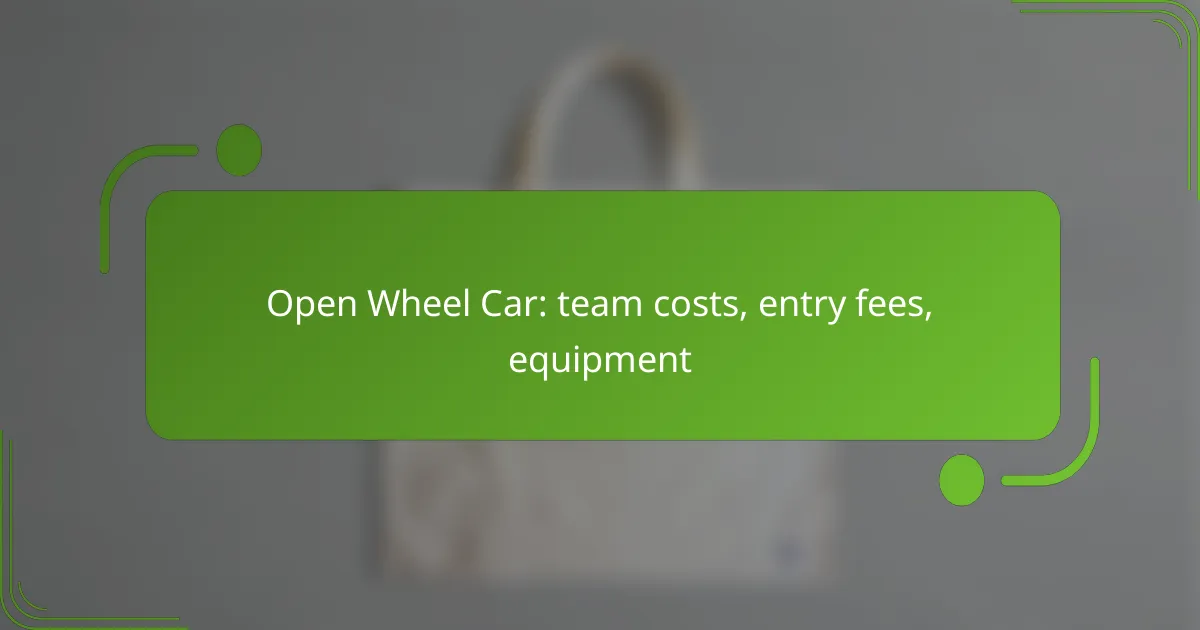Entering open wheel racing in Canada requires careful financial planning due to various costs, including team expenses, entry fees, and equipment investments. Depending on the level of competition and the specific series, teams may need to budget tens of thousands to several million dollars for essential components like chassis and engines, as well as ongoing expenses such as fuel, tires, and staff salaries.

What are the costs of entering open wheel racing in Canada?
Entering open wheel racing in Canada involves various costs, including team expenses, entry fees, and equipment investments. These costs can vary significantly based on the level of competition and the specific series in which a team participates.
Team costs overview
Team costs in open wheel racing typically encompass salaries, logistics, and operational expenses. For a small team, annual costs can range from hundreds of thousands to several million Canadian dollars, depending on the scale of operations and the level of competition.
Key expenses include hiring skilled personnel such as engineers and mechanics, as well as costs for transportation, accommodation, and race-day operations. Budgeting for these elements is crucial for maintaining a competitive edge.
Entry fees for Canadian series
Entry fees for open wheel racing series in Canada can vary widely based on the series and the level of competition. Fees may range from a few thousand to tens of thousands of Canadian dollars per event.
For example, regional series might charge lower fees compared to national championships, which often include additional costs for licensing and insurance. Teams should carefully review the fee structure of each series to plan their budgets effectively.
Budgeting for equipment
Investing in equipment is a significant part of entering open wheel racing. Costs for a competitive car can start in the low hundreds of thousands of Canadian dollars and can escalate into the millions for top-tier vehicles.
Essential equipment includes the car itself, tires, fuel, and spare parts. Teams should also consider ongoing maintenance and upgrades, which can add to the overall budget. Prioritizing spending on critical components can help teams stay competitive without overspending.

How much does equipment cost for open wheel racing?
Equipment costs for open wheel racing can vary significantly based on the level of competition and the type of vehicle. Generally, teams should budget tens of thousands to several million dollars for comprehensive setups, including chassis, engines, and maintenance.
Chassis pricing for Formula cars
The cost of a chassis for Formula cars typically ranges from around $100,000 to over $1 million, depending on the series and specifications. For instance, entry-level Formula series may offer chassis in the lower range, while top-tier categories like Formula 1 can reach exorbitant prices due to advanced materials and technology.
When considering chassis purchases, teams should factor in not only the initial cost but also the potential for resale value and performance upgrades. It’s essential to choose a chassis that aligns with the team’s competitive goals and budget constraints.
Engine costs for open wheel vehicles
Engine costs for open wheel racing can vary widely, from approximately $50,000 for lower-tier series to several million dollars for high-performance engines used in Formula 1. The price often reflects the engine’s complexity, power output, and the level of engineering involved.
Teams should also consider ongoing costs related to engine maintenance and rebuilds, which can add significantly to the overall budget. It’s advisable to establish relationships with reliable engine suppliers to ensure consistent performance and support throughout the racing season.
Maintenance expenses
Maintenance expenses for open wheel racing can be substantial, often accounting for a significant portion of a team’s budget. Regular maintenance, including inspections, repairs, and component replacements, can cost tens of thousands of dollars per season.
To manage these costs effectively, teams should implement a proactive maintenance schedule and invest in quality parts. Additionally, having skilled technicians on staff can help reduce long-term expenses by minimizing the need for external services.

What are the ongoing expenses for an open wheel racing team?
The ongoing expenses for an open wheel racing team encompass a variety of costs that are essential for maintaining competitive performance. These expenses include fuel, tires, staff salaries, insurance, and registration fees, all of which can significantly impact the team’s budget.
Fuel and tire costs
Fuel and tire costs are critical ongoing expenses for any open wheel racing team. Fuel consumption can vary based on the type of racing and track conditions, but teams often spend thousands of dollars per race on fuel alone. Tire costs can be even more substantial, as teams may need to purchase multiple sets for a single event, with prices ranging from hundreds to thousands of dollars depending on the tire specifications.
Teams should carefully manage their tire strategies to optimize performance while minimizing costs. This includes selecting the right tire compounds for different track conditions and understanding the wear rates to avoid unnecessary purchases.
Staff salaries and logistics
Staff salaries represent a significant portion of an open wheel racing team’s budget. This includes not only the drivers but also engineers, mechanics, and support staff, with total payroll often reaching into the hundreds of thousands or even millions of dollars annually. Effective team management is crucial to ensure that the right personnel are in place to maximize performance.
Logistics also play a vital role in ongoing expenses. Transporting equipment and personnel to various race locations can incur substantial costs, including fuel for transport vehicles, lodging, and meals. Teams should plan their logistics carefully to avoid overspending while ensuring that all necessary resources are available at each event.
Insurance and registration fees
Insurance and registration fees are necessary expenses that open wheel racing teams must account for. Insurance coverage can include liability, vehicle damage, and personal injury, with costs varying widely based on the level of coverage and the team’s racing history. Teams should shop around for the best rates while ensuring adequate protection.
Registration fees for races can also add up, often requiring teams to pay several hundred to several thousand dollars per event. It’s essential for teams to budget these fees in advance to avoid financial strain during the racing season.

What are the prerequisites for joining an open wheel racing team?
Joining an open wheel racing team requires specific qualifications, including a valid racing license, relevant experience, and financial backing for entry fees and equipment. Understanding these prerequisites is essential for aspiring drivers and team members.
Licensing requirements in Canada
In Canada, drivers must obtain a racing license from a recognized sanctioning body, such as the Canadian Automobile Sports Clubs (CASC) or the Automobile Competition Committee for the United States (ACCUS). The licensing process typically involves completing a training program, passing a written exam, and demonstrating driving skills on a track.
Additionally, drivers may need to participate in a certain number of practice sessions or races to qualify for higher-level licenses. Fees for obtaining a license can vary, generally ranging from a few hundred to over a thousand Canadian dollars, depending on the level of certification.
Experience needed for drivers
Experience is crucial for drivers looking to join an open wheel racing team. Most teams prefer candidates with prior racing experience, ideally in karting or lower-tier formula racing. This foundational experience helps drivers develop essential skills such as car control, race strategy, and track awareness.
For those new to the sport, starting in karting or participating in amateur racing leagues can provide valuable experience. Aspiring drivers should aim to log significant track time and participate in various racing events to build their resume and improve their chances of being recruited by a professional team.

How do entry fees vary across different open wheel racing series?
Entry fees for open wheel racing series can differ significantly based on the level of competition and the specific series. Generally, fees can range from a few thousand to tens of thousands of dollars, depending on the series’ prestige and the resources required for participation.
Comparison of fees in Formula 4 and Formula 1600
Formula 4 typically has higher entry fees compared to Formula 1600 due to its more advanced cars and greater media exposure. For instance, entry fees for Formula 4 can range from around $10,000 to $20,000 per season, while Formula 1600 fees may be closer to $5,000 to $10,000.
Additionally, teams in Formula 4 often incur higher costs for equipment, support, and logistics, which can further increase the overall budget needed for participation. In contrast, Formula 1600 is more accessible for amateur drivers and smaller teams, making it an attractive entry point into open wheel racing.
Regional differences in entry costs
Entry costs for open wheel racing can vary significantly by region, influenced by factors such as local sponsorship opportunities and the popularity of the series. In Europe, for example, entry fees for competitive series like Formula Renault can be higher, often exceeding €20,000, while in North America, similar series may charge around $15,000.
Moreover, regional regulations and the availability of tracks can impact costs. In some areas, additional fees for licensing, insurance, and track usage may apply, making it essential for teams to budget accordingly. Understanding these regional differences is crucial for teams planning to compete in various markets.

What are the financing options for aspiring open wheel teams?
Aspiring open wheel teams can explore various financing options, including sponsorships, personal investments, and crowdfunding. Each option has its advantages and challenges, and teams should carefully assess their financial needs and potential returns before committing to a strategy.
Sponsorship opportunities
Sponsorships are a primary source of funding for open wheel teams, providing financial support in exchange for brand visibility. Companies often seek to associate their brands with the excitement of motorsport, making this a mutually beneficial arrangement.
To attract sponsors, teams should develop a compelling marketing proposal that outlines potential exposure, including race attendance, media coverage, and social media reach. Common sectors for sponsorship include automotive, technology, and consumer goods, with deals ranging from thousands to millions of dollars depending on the team’s profile and reach.
It’s crucial for teams to maintain strong relationships with sponsors by delivering on promises and providing regular updates on performance and visibility. This can lead to long-term partnerships and increased funding opportunities in the future.
